Create lavish moods and textures and be inspired by three stunning vistas from June Blake's garden.
Each has an overview photograph and then we zoom in for the details.
Scroll down to see each of the three views and all the planting featured.
The first view is entitled…
All about flowers

In spring this area hosts thousands of tulips and later alliums with the emerging foliage of herbaceous perennials. I use a lot of vertical plants such as veronicas, Acanthus spinosus and Persicaria amplexicaulis ‘Fat Domino’. Pops of colour come from Geranium ‘Anne Thomson’, Monarda ‘Jacob Cline’ and Helenium ‘Sahin’s Early Flowerer’. During the season I edit if necessary, cutting back or removing plants and making more suitable additions. It is important to keep this bed fresh and vibrant so I continually deadhead.
Inside this view you'll find:
1
Monarda ‘Jacob Cline’

I can’t resist its beautiful, red flowers and scented, lacy foliage. Adored by bees, it’s almost totally mildew resistant and towers above other plants from midsummer until late autumn. 90cm. RHS H4, USDA 4a-9b†.
2
Geranium ‘Anne Thomson’

The best and longest-flowering geranium in my garden, with beautiful, magenta flowers and lime-green foliage. I avoid cutting it back after the first flush of flowers as it will push up new foliage and more flowers until October. 50cm. AGM*. RHS H7.
3
Eryngium x zabelii ‘Big Blue’

A terrific sea holly that returns year after year. Huge heads of steely blue, prickly flowers extend down the stems and attract masses of bees. Enjoys good, rich soil and flowers for months if deadheaded. 1m. AGM. RHS H5, USDA 5a-9b.
4
Persicaria amplexicaulis ‘Fat Domino’

A excellent, long-flowering plant with long, fat spikes of rich-red flowers. I find it way superior to many other red persicarias, which can become large leafy plants over time. Mine flower from early July to October. 75cm-1m. RHS H7.
5
Helenium ‘Sahin’s Early Flowerer’

Prolific orange flowers with a chocolate- brown centre from late June to mid-September. I divide this plant every few years and mass plant in beds. Deadhead carefully for a second flush of flowers. 90cm. AGM. RHS H7.
6
Veronicastrum virginicum ‘Erica’

A really elegant plant with tall, pink spikes that works well with other V. virginicum cultivars in this border: the deep-blue ‘Apollo’, and ‘Diane’, which has long spikes of pure-white flowers and lots of sid hoots. 1.5m. RHS H4, USDA 3a-8b.
*Holds an Award of Garden Merit from the Royal Horticultural Society. †Hardiness ratings given where available.
Time for our second view…
Tropical paradise
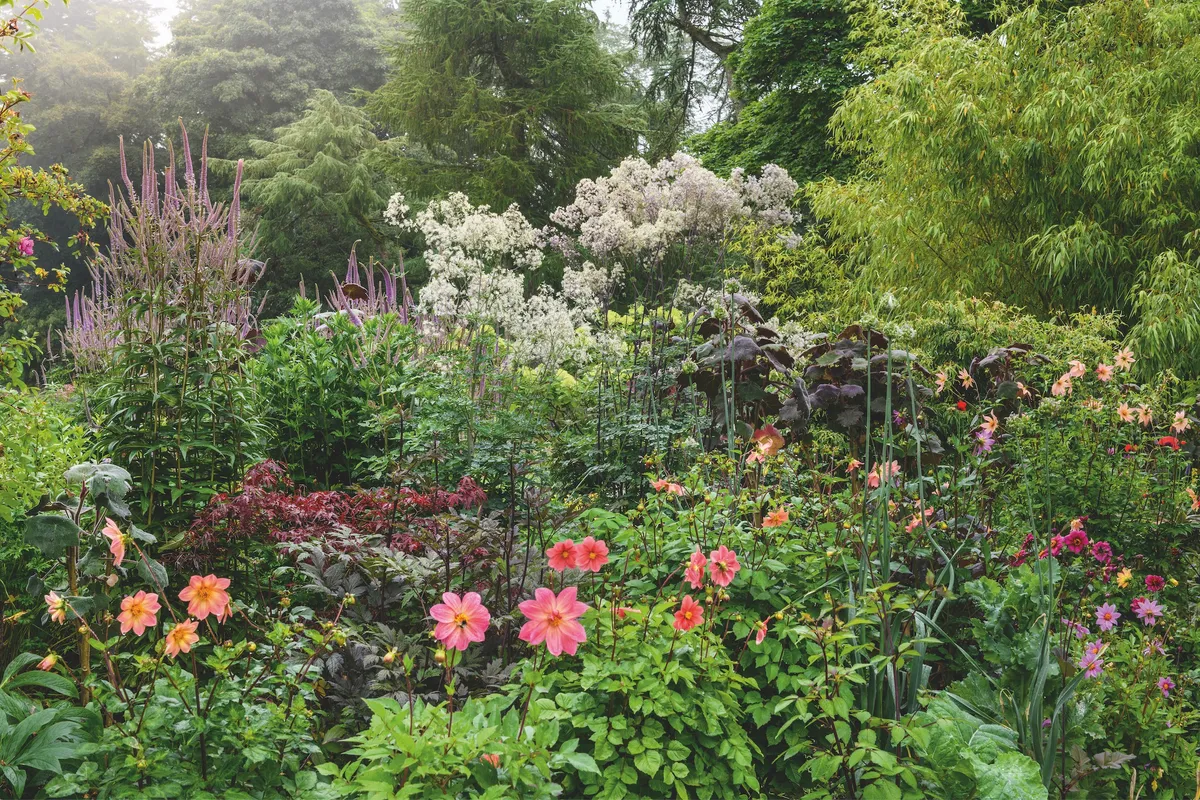
The permanent plants in this area are Phyllostachys vivax f. aureocaulis ‘Huangwenzhu’, Thalictrum ‘Elin’ and Veronicastrum virginicum ‘Fascination’. In spring, masses of ‘Ballerina’, ‘Paul Scherer’ and ‘Purple Dream’ tulips flower between the emerging foliage of perennials. Once the danger of frost has passed, I plant out my tender plants.
All my dahlias are grown from seed so I select the most suitable colours for different areas of the garden. Here I use shades of pink and purple, which work well with the lavender flowers of Thalictrum ‘Elin’ and the large, purple-tinged leaves of Roldana cristobalensis, one of my favourite tropical plants. When it is planted out in late May this area is immediately transformed into a lush, tropical garden.
Inside this view you'll find:
7
Veronicastrum virginicum ‘Fascination’

A long-flowering veronica with long spikes of lilac flowers adored by bees. I don’t stake it but I tie some garden twine around its middle as it grows to stop the plants splitting in heavy rain or wind. 1.8m. RHS H7, USDA 3a-8b.
8
Thalictrum ‘Elin’

Emerges in April with striking, lacy, blue-green foliage. In summer it is covered in elegant sprays of lavender flowers that fade to white. 2.5m. AGM. RHS H7.
9
Dahlia seedlings

If deadheaded they will flower continually until first frost. Every autumn I collect seeds for sowing in April, and dig most up in early winter to store in a shed. I pot them up in late March and place in a polytunnel until late May or early June, depending on the weather. 1-3m. USDA 7a-10b.
10
Roldana cristobalensis
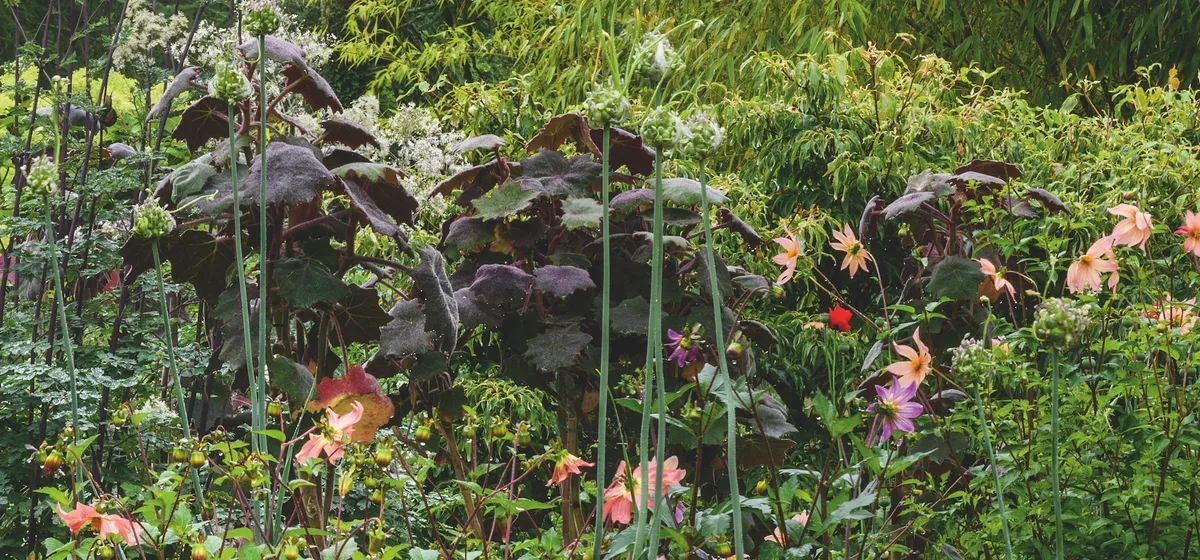
A dramatic plant with large, dinner-plate leaves that are green on top and purple underneath with beautiful, fuzzy, pink stems. Cuttings can be taken at any time except winter; I place them in pure granite sand and pot on once they produce roots. 1.8-2m.
11
Phyllostachys vivax f. aureocaulis ‘Huangwenzhu’

A tall, arching bamboo with olive-green canes that have a yellow stripe. I strip the bottom leaves and thin out crooked canes. It’s a terrific backdrop and resistant to wind damage. 6m.
And finally, our third…
Mood music
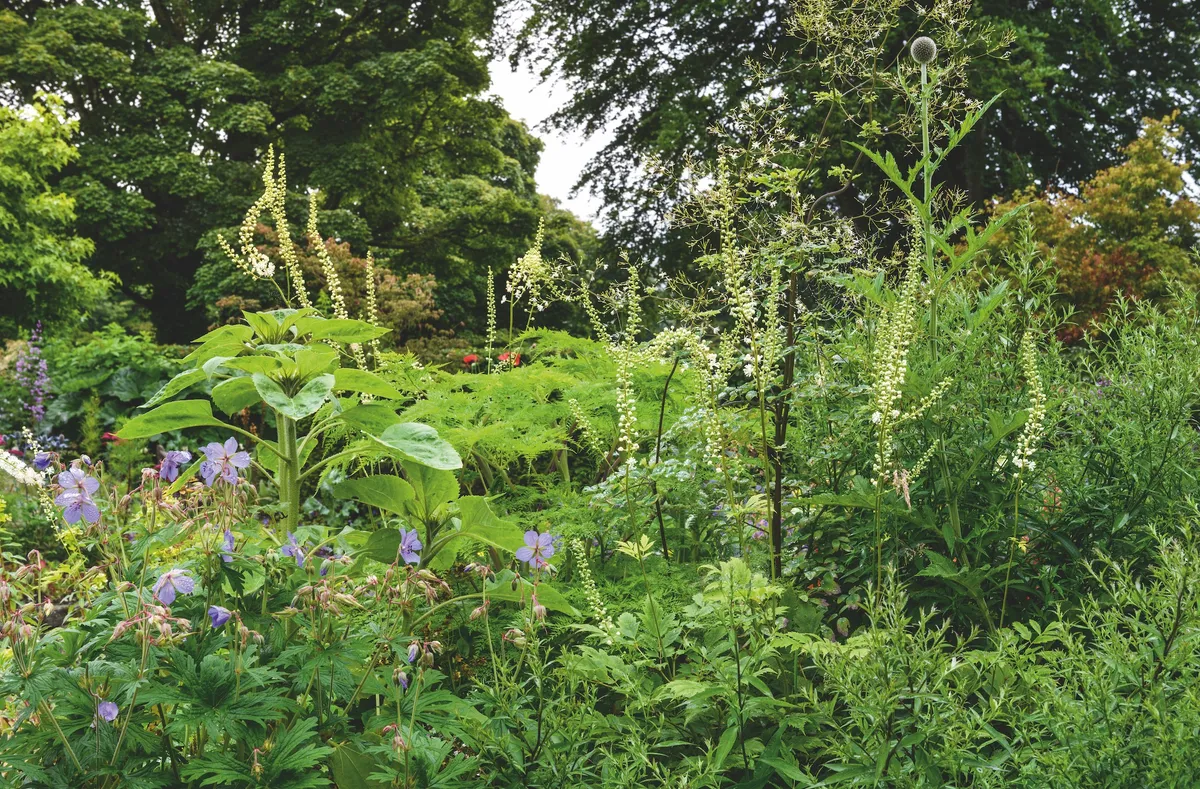
I used three key plants here – Actaea racemosa, Echinops sphaerocephalus ‘Arctic Glow’ and Selinum wallichianum – to create a calm area with muted colours of white and green and lots of contrasting foliage (my guerilla-gardening granddaughter Ruby secretly planted the sunflower, which wasn’t part of the original plan).
I love Selinum wallichianum for its beautiful, delicate, feathery foliage. It doesn’t flower until early autumn when it produces lovely white umbels much loved by bees. Actaea racemosa is spot planted throughout the bed. I particularly like the fresh foliage, which emerges through the tulips. It starts to flower here in midsummer, and produces long, soft spikes of white flowers that seem to float high above all the other plants.
The echinops I use sparingly. Its foliage can be untidy so is best hidden behind other plants, but I love the contrast of round, white flowers with the spiky flowers of the actaea and the flat umbels of the selinum.
Inside this view you'll find:
12
Geranium pratense
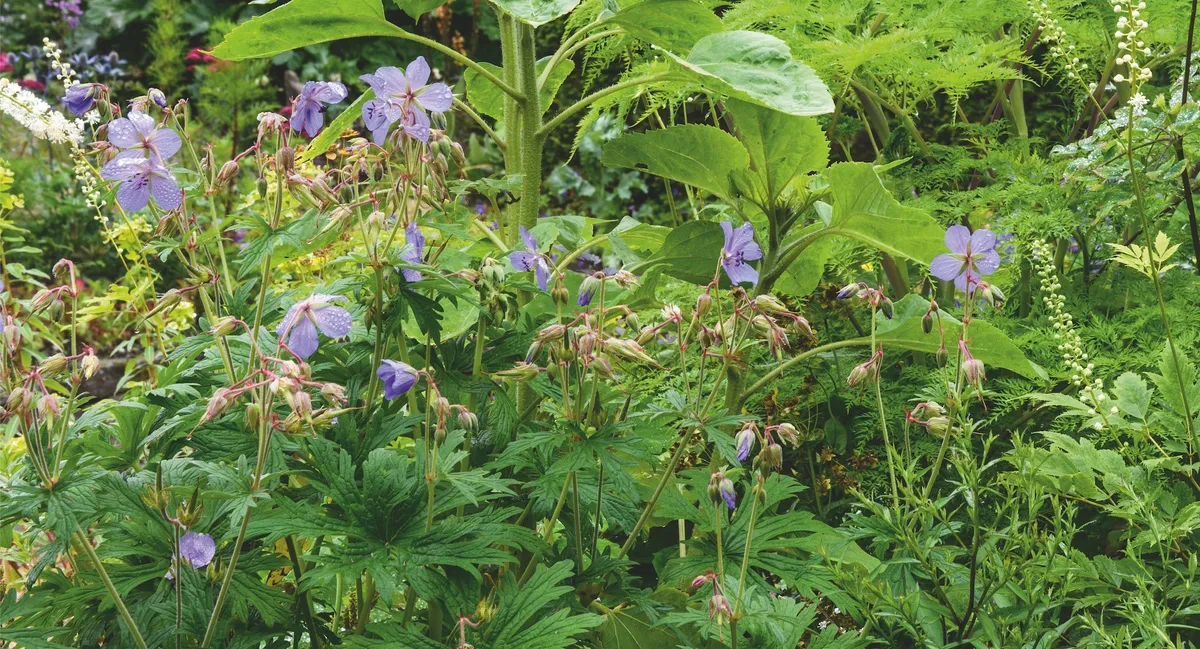
Although beautiful, this species can be invasive. Sometimes it seeds exactly where it’s needed; other times it smothers a special, delicate plant. It self-seeds here and works well as the plants surrounding it are robust, but I’m ruthless and cut it back completely. 90cm. RHS H7, USDA 4a-8b.
13
Actaea racemosa

A North American woodland native commonly called black cohosh. It has fresh, deep-green leaves with finely divided foliage and produces beautiful, graceful, arching wands of fragrant white flowers in mid- to late summer. The fluffy spikes seem to float high over other plants. 1.5m. AGM. RHS H7, USDA 3a-8b.
14
Selinum wallichianum
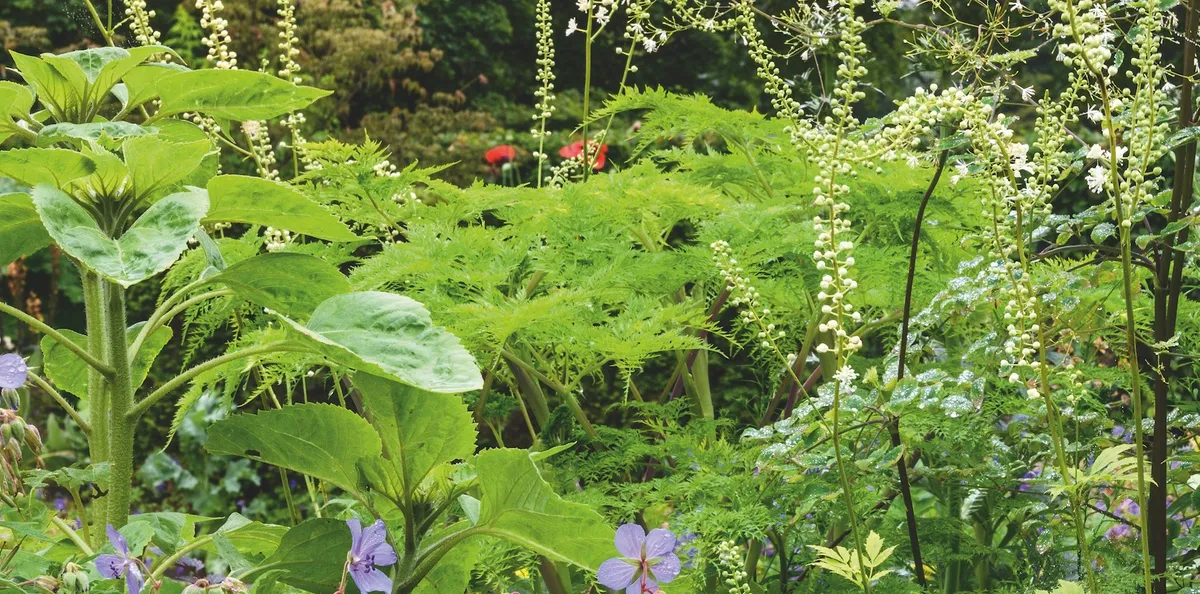
A late-flowering, perennial milk parsley that I use extensively. I love the beautiful, ferny foliage that always looks fresh and healthy. The white flowers are an additional bonus in late summer and much loved by bees. Unlike other umbellifers, it doesn’t self-seed. Without doubt one of the most elegant and reliable plants in the garden. 90cm-1.6m. AGM. RHS H6.
15
Echinops sphaerocephalus ‘Arctic Glow’

This is a vigorous perennial with strong, dark-reddish stems and lovely, round balls of white, starry flowers and silvery- green foliage. It flowers in late summer and seedheads last well into the winter. 90cm. RHS H7, USDA 3a-10b.
USEFUL INFORMATION
Address June Blake’s Garden, Tinode, Blessington, Co Wicklow, Ireland W91 EC90.
Tel + 353 (0)872 770399. Web juneblake.ie Open April to September. Wednesday to Sunday, 11am to 5pm.